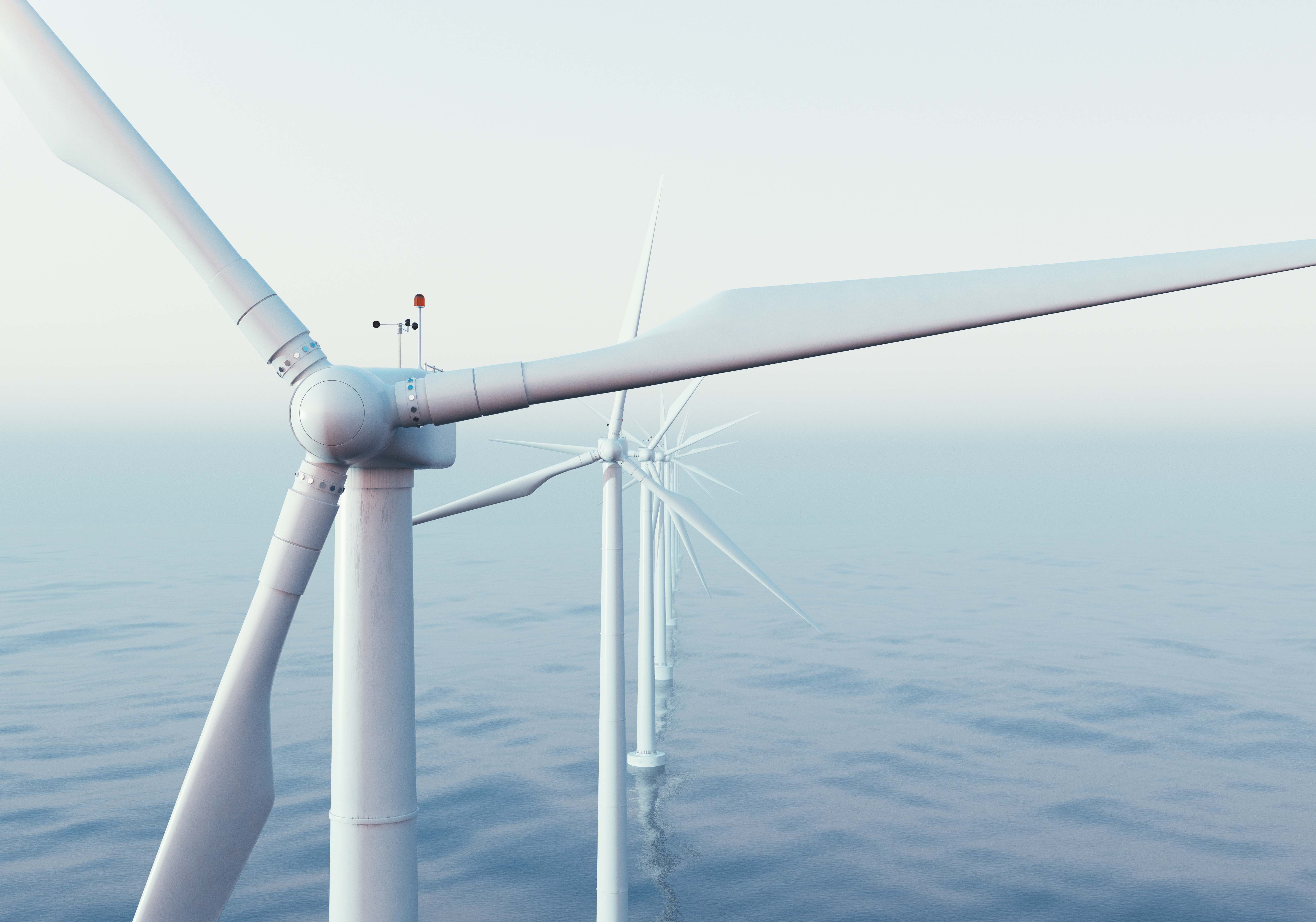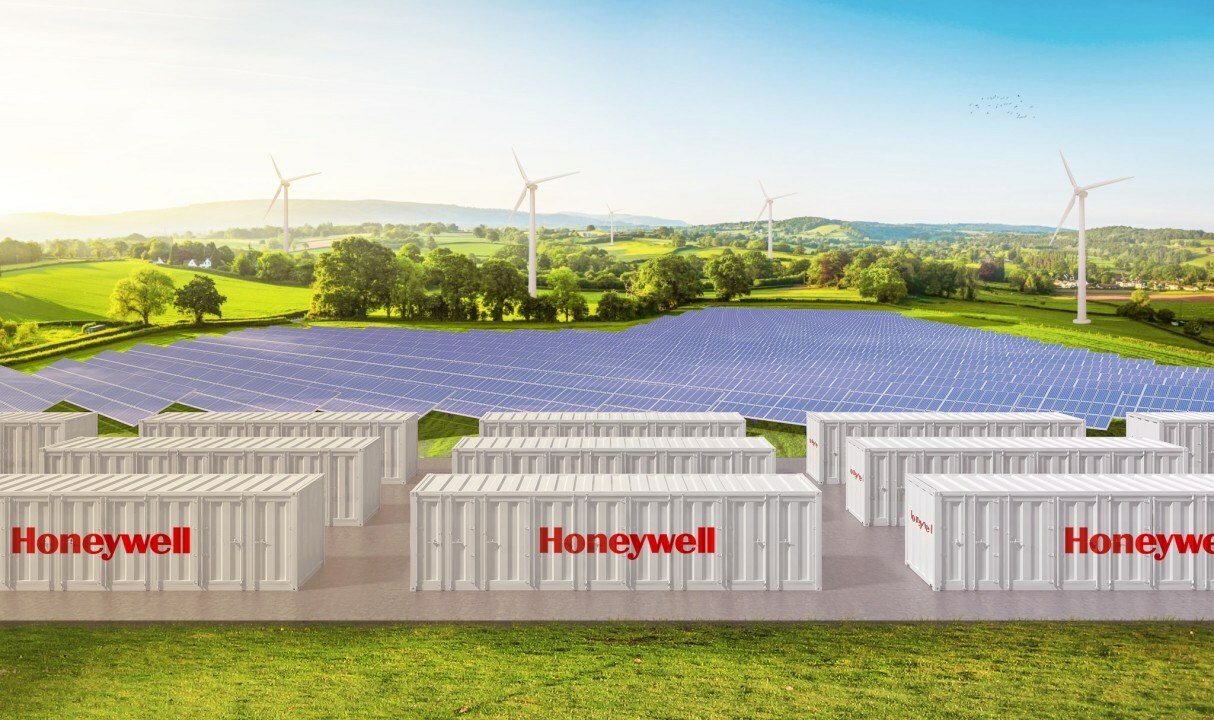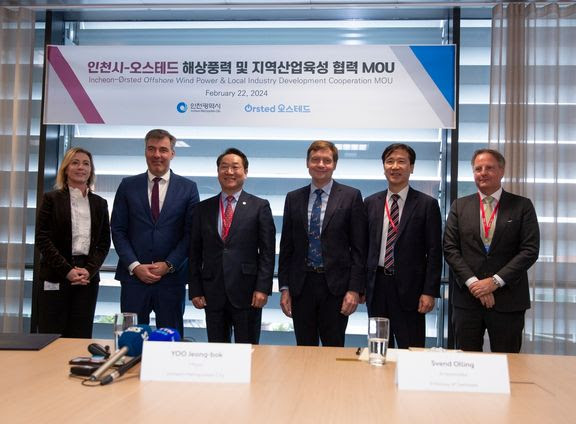Equinor secured key permitting needed to move forward with the Empire Wind project offshore New York with the U.S. Bureau of Ocean Energy Management’s (BOEM) Feb. 22 approval of the project’s construction and operations plan, the company said.
The plan includes two offshore wind facilities—Empire Wind 1 and Empire Wind 2—with a combined capacity of more than 2 gigawatts (GW)—enough to power over 700,000 homes annually by BOEM estimates. Empire Wind 1 will have up to 57 wind turbines, while Empire Wind 2 will consist of up to 90 wind turbines.
The plan was first submitted in 2020.
“This project represents a major milestone in our efforts to expand clean energy production and combat climate change,” BOEM’s Director Elizabeth Klein said in a statement. “The Biden-Harris administration is committed to advancing offshore wind projects like Empire Wind to create jobs, drive economic growth and cut harmful climate pollution.”

The U.S. set a goal to increase offshore wind energy capacity to 30 GW by 2030. However, efforts by some industry players to advance projects have been impacted by inflation, high interest rates and supply chain woes.
The issues prompted some companies to renegotiate or terminate contracts to sell power. Looking to capture better agreements, Equinor and then partner BP announced in January it reached an agreement to end their contract to sell power from Empire Wind 2 as part of a deal with the New York State Energy Research and Development Authority.
New York allowed companies to exit old contracts and seek newer ones at higher prices. Currently, Empire Wind 1 is bidding into New York’s fourth offshore wind solicitation.
Equinor said Empire Wind 1 could deliver first power to New Yorkers by 2026. The project is on track to begin construction offshore Long Island later this year.
“We are ready to get to work,” said Molly Morris, president of Equinor Renewables Americas. “Today’s COP approval follows years of rigorous review and collaboration with BOEM and other federal agencies. Equinor is grateful for a shared commitment to achieving state and federal offshore wind ambitions, and Empire Wind is one step closer to delivering renewable power to hundreds of thousands of New York homes.”
Here’s a look at other renewable energy news:
Energy storage
BlackRock, Temasek-led Group Invest $150MM in Thermal Battery Maker Antora
Thermal battery maker Antora Energy on Feb. 22 said it raised $150 million in a funding round led by a tie-up between the world’s biggest asset manager BlackRock and Singapore state investment firm Temasek.
The BlackRock-Temasek partnership, called Decarbonization Partners, led an investor group including Emerson Collective, GS Futures, The Nature Conservancy, Lowercarbon Capital, Breakthrough Energy Ventures and top global miner BHP’s venture capital unit.
The fresh financing for the startup will underpin an increase in production of its batteries—blocks of solid carbon heated with renewable energy.
Energy from those batteries could be used in industrial processes that use heat to melt and change raw ingredients in sectors from chemicals to concrete.
Antora or its customer would buy renewable energy at times of the day when prices are lowest to heat up the batteries to as much as 2,400 C (4,352 F). Customers could draw on that heat throughout the day, potentially decarbonizing areas of the economy seen as particularly wedded to fossil fuel use.
The thermal battery combined with cheap renewable energy marks “the first opportunity for decarbonizing industrial emissions in a way that’s cost competitive with fossil fuels,” Antora co-founder and CEO Andrew Ponec said in an interview.
The heat can also be turned into electricity through California-based Antora’s thermophotovoltaic technology.
SQM Lithium Ventures Doles Out $9.4MM More to Cleantech Group Altilium
U.K.-based Altilium said it secured a $9.43 million investment from SQM Lithium Ventures, the corporate venture arm of Sociedad Quimica y Minera de Chile’s lithium business.
The investment, which marks SQM’s largest to date in the company, brings its total investment to about $12 million.
“Going forward, the additional funding will accelerate the scale-up of Altilium’s U.K. and European activities, paving the way for the roll-out of the company’s full battery circularity customer offering, encompassing zero-carbon EV battery collection, black mass recycling and chemical refining direct to cathode active material (CAM),” Altilium said in a news release.
The cleantech company, which provides cathode and anode battery materials from recycling waste, received an initial investment of $2.57 million from SQM Lithium Ventures in 2023.
Hydrogen
Honeywell, Green Solutions Partner on Hydrogen Project in Vietnam

Honeywell and The Green Solutions Group Corp. (TGS) agreed to collaborate on Vietnam’s first green hydrogen plant in the Mekong Delta region.
Called Tra Vinh, the green hydrogen project will utilize 240-megawatt (MW) electrolyzers powered by wind and solar energy with battery energy storage systems, according to TGS.
As part of the agreement, Honeywell said it will provide solutions and expertise covering the entire hydrogen value chain to help enable TGS.
“Honeywell’s battery energy storage system will play a key enabling role in the Tra Vinh green hydrogen project,” said Ramanathan Valliyappan, regional general manager of Honeywell Process Solutions. “It will extend renewable energy from TGS’ solar farms beyond sunlight time as well as extend wind power when the winds are calm.”
The agreement was reached as Vietnam targets net-zero emissions by 2050.
Vietnam Aims to Produce Up To 500,000 Tons of Hydrogen Per Year by 2030
Vietnam aims to produce 100,000 metric tons (mt)-500,000 mt of hydrogen per year by 2030 as part of its energy transition efforts, according to the country’s hydrogen development strategy adopted earlier this February.
The output would be raised to 10 MMmt-20 MMmt by 2050, including green hydrogen, according to a government document detailing the strategy reviewed by Reuters.
The production, distribution and usage of hydrogen will help “meet the country’s national targets for climate change, green growth and to meet its net zero target by 2050,” the document said.
Hydrogen is categorized “green” when it is extracted from water using electrolysis powered by renewable energy and is seen as crucial to decarbonization, though the technology is still expensive and at an early stage of development.
The hydrogen output will partly replace natural gas and coal at power plants by 2030, the document said, adding that hydrogen will also be used for transport and for fertilizer, steel and cement production.
By 2050, hydrogen will be responsible for 10% of the country’s electricity generation, it added.
Vietnam will mobilize both public and private funds for hydrogen production, including from green bond issuance and from Just Energy Transition Partnership (JETP), a financing scheme made up of equity investments, grants and concessionary loans from members of Group of Seven (G7), multilateral banks and private lenders.
Germany Earmarks up to $3.8B for Future Green Hydrogen Imports
Germany will earmark up to 3.53 billion euros (US$3.8 billion) of public funds to procure green hydrogen and its derivatives between 2027 and 2036, the economy ministry said Feb. 20, as Berlin bets on the fuel to help decarbonize Europe’s biggest economy.
“The aim of the funding measure is to bring together supply and demand, both in terms of quantities and prices,” the ministry said in a statement, adding that money will come from the government’s Climate and Transformation Fund.
Germany is seeking to expand reliance on hydrogen as a future energy source to cut greenhouse gas emissions for highly polluting industrial sectors that cannot be electrified, such as steel and chemicals, and reduce its dependency on imported fossil fuels.
Berlin will have to import up to 70% of its hydrogen needs in the future as Europe’s largest economy aims to become climate-neutral by 2045, according to the government’s updated hydrogen strategy published last summer.
The earmarked funds will be used to compensate for the difference between supply and demand prices, the ministry said, adding that it was discussing the details of the use of the new funding with the European Commission.
RELATED
Plug Power Finalizes Contract with US Auto Manufacturer
RNG
Ameresco Starts RNG Production at Republic Services Landfill
Cleantech company Ameresco Inc. on Feb. 20 said it started commercial operations at Republic Services’ Brickyard Landfill, transforming landfill gas into pipeline quality renewable natural gas (RNG).
Located in Danville, Illinois, the facility is capable of processing 2,000 standard cubic feet of gas per minute and has a capacity of 500,000 dekatherms (500 MMcf) of RNG per year. The facility is designed to remove more than 27,000 tons of CO2 emissions per year that would have otherwise been produced by diesel-burning vehicles, for example, according to a news release.
“At Republic Services, we’re committed to supporting decarbonization, and our partnership with Ameresco has helped us accelerate progress toward our 2030 sustainability goals,” said Tim Oudman, senior vice president of sustainability innovation for Republic Services. “Through the Brickyard RNG facility, we’re able to transform naturally occurring biogas into renewable energy for the local community.”
The facility marks Ameresco’s 12th renewable energy project with Republic Services. The two companies are working together on another 10 projects as Republic Services aims to beneficially reuse 50% more biogas by 2030.
“Creating clean energy, reducing harmful emissions and making a tangible impact on the environment towards a carbon-neutral future depends on collaboration,” said Michael Bakas, executive vice president of Ameresco. “Through our long-term partnership with Republic Services, we were able to create a dispatchable baseload resource at the Brickyard Landfill.”
RELATED
One Man's Trash? Treasure of RNG Prospects Available for Waste Facilities
Ameresco Starts RNG Production at Republic Services Landfill
Solar
SunPower Secures $300MM in Funding for Solar, Storage Programs
Residential solar company SunPower Corp. has lined up more than $300 million in project financing commitments for its residential solar and storage lease programs, the California-based company said Feb. 23.
The commitments were from funds managed by Apollo, ATLAS SP Partners and Hannon Armstrong Sustainable Infrastructure Capital Inc., according to a news release.
“We believe this new commitment will enable us to better serve our growing base as we can now provide significantly more customers with leases for solar and storage solutions, meet the strong demand for our fastest growing financial product and ultimately expand access to clean energy at scale,” SunPower CEO Peter Faricy said.
The latest capital raise gives the company access to more than half a billion dollars of capital.
Lightsource BP Closes $348MM in Financing for Texas Solar Projects
Lightsource BP secured a $348 million financing package that will help the company construct two utility-scale solar projects in Texas, the company said Feb. 21.
The financing is for the 163-MW Starr Solar project in Starr County and the 125-MW Second Division Solar project in Brazoria County. Both are scheduled to come online in 2024, the company said, joining three other solar projects operated by Lightsource BP in Texas.
“This deal is an important milestone towards building out our growing portfolio of solar and storage projects across the United States, extending our relationship with several top-tier financing counterparties, each of whom have partnered with Lightsource BP on previous transactions,” said Emilie Wangerman, head of USA and interim COO for Lightsource BP. “It’s also our first transaction to benefit from the transferability provisions of the Inflation Reduction Act of 2022 to monetize the projects’ investment tax credits.”
Lenders arranging debt facilities related to the financing included Societe Generale, ING Capital, NatWest, Lloyds Banking Group and Allied Irish Banks.
Wind
Ørsted, Incheon City Partner to Establish Offshore Wind in Region

Ørsted and South Korea’s Incheon City plan to work together to develop an offshore wind industry led by the company’s 1.6-GW offshore wind project, according to a Feb. 22 news release.
In addition to establishing policies and infrastructure for offshore wind, Incheon City will provide administrative support as part of the agreement. Ørsted will develop its project using a model that is mutually beneficial to local residents, businesses and suppliers, the release states.
“We have a strong track record working with Korean suppliers in our global portfolio over the past decade,’ Thomas Thune Andersen, chair of Ørsted’s board of directors. “We’ll build on this legacy of collaboration with our Incheon project, which will lead the way for a thriving offshore wind industry by generating reliable renewable energy, attracting long-term investments and creating jobs.”
Located about 70 km off the coast of Incheon City, the Incheon wind farm is expected to be operational from 2030.
Hexicon Acquires Full Ownership Stake in South Korea Floating Wind Project
Floating wind developer Hexicon on Feb. 22 said it agreed to take full ownership of the approximately 1.13-GW MunmuBaram floating offshore wind farm from joint venture partner Shell Overseas Investments.
Shell’s exit from the project increases Hexicon’s stake from 20% to 100%.
Hexicon will pay Shell a first down payment of $5 million and up to an additional $50 million as part of a three-year profit-sharing agreement.
“South Korea continues to be a leading market with good conditions for the development of floating offshore wind,” said Hexicon CEO Marcus Thor. “Through this transaction, South Korea remains a core market for Hexicon and strengthens our position as a leading global developer of floating offshore wind.”
Hexicon said its full ownership of the project, located offshore Ulsan City in southeastern South Korea, is enabled by support from U.K. infrastructure fund Glennmont Partners.
First Major US Offshore Wind Farm Powering 30,000 Homes
Vineyard Wind, the first large-scale U.S. offshore wind farm, is sending enough power from five turbines off the Massachusetts coast to power 30,000 homes, the project’s owners said Feb. 22.
The announcement is a key milestone for both the project and the budding U.S. offshore wind industry, which has been plagued by soaring costs and delays. The sector is a critical part of President Biden’s goal to decarbonize the U.S. power sector and combat climate change.
Vineyard Wind is providing 68 MW of electricity to the New England grid, according to joint owners Avangrid and Copenhagen Infrastructure Partners. Once it is completed, it is expected to supply 806 MW from 62 turbines, enough to power 400,000 homes and businesses.
“This marks a turning point in the clean energy transition. After many decades of advocacy, research, policymaking, and finally, construction, America’s offshore wind industry has gone from a dream to reality,” Massachusetts Governor Maura Healey said in a statement.
Vineyard Wind is located 15 miles (24 km) off the coast of Martha’s Vineyard. So far, nine of the expected 62 turbines have been installed, and each will begin generating power as they are completed.
RELATED
Stonepeak, Dominion Energy to Partner on Virginia Offshore Wind Project
Hybrid
EDP Renewables Commissions Solar, Wind Project in Portugal
EDP Renewables commissioned Portugal’s second hybrid park combining the new 21-MW Monte de Vez photovoltaic solar plant with the existing 22.8-MW São João Wind Farm.
The solar plant includes 36,000 bifacial panels, while the wind farm features 13 wind turbines in the municipalities of Penela, Coimbra district, and Ansião, Leiria district. Together, the hybrid park is expected to eliminate the 40,000 tons of CO2 emissions annually, EDP said in a Feb. 22 news release.
“This project is part of EDP’s strategy to continue accelerating the national energy transition, whether by investing in new renewable projects or optimizing those that have already served the regions where they are located,” Hugo Costa, head of EDP Renováveis in Portugal.
EDP plans to install another 700 MW in similar projects in the coming years, he said.
Reuters and Hart Energy Staff contributed to this report.
Recommended Reading
For Sale, Again: Oily Northern Midland’s HighPeak Energy
2024-03-08 - The E&P is looking to hitch a ride on heated, renewed Permian Basin M&A.
E&P Highlights: Feb. 26, 2024
2024-02-26 - Here’s a roundup of the latest E&P headlines, including interest in some projects changing hands and new contract awards.
Gibson, SOGDC to Develop Oil, Gas Facilities at Industrial Park in Malaysia
2024-02-14 - Sabah Oil & Gas Development Corp. says its collaboration with Gibson Shipbrokers will unlock energy availability for domestic and international markets.
E&P Highlights: Feb. 16, 2024
2024-02-19 - From the mobile offshore production unit arriving at the Nong Yao Field offshore Thailand to approval for the Castorone vessel to resume operations, below is a compilation of the latest headlines in the E&P space.
TotalEnergies Acquires Eagle Ford Interest, Ups Texas NatGas Production
2024-04-08 - TotalEnergies’ 20% interest in the Eagle Ford’s Dorado Field will increase its natural gas production in Texas by 50 MMcf/d in 2024.






